|
Dresdens: Exquisite Paper Ornaments
By Betty H. Bell
Posted December 2016

Among the most beloved, highly prized decorations used on American Christmas trees are Dresden ornaments, referred to as "Dresdens." Fascinating, fanciful and colorful, these ornaments were made in and around Dresden, Germany, from 1870 until World War I. Although they were produced in large quantities, few have survived.
|
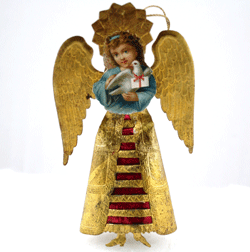
|

|
|
An angel with conical skirt for use as a tree topper or ornament; selling for less than $1,000.
|
A green iridescent peacock ornament, under $2,000.
|
With the increasing enthusiasm for Christmas decorating and celebration in the last half of the 19th century, Americans began to decorate their homes with fresh greens, fruit and nuts and adorn freshly-cut trees with colorful threads and garlands of popcorn and colored paper chains. By 1850, Christmas was definitely in vogue, encouraged by New Yorkers and magazines, such as Harper's and Godey's Lady's Book. In 1857, the first decorated tree appeared at the White House, set up by President Franklin Pierce, and this new custom helped to popularize the tree.
Toy agents began bringing beautiful ornaments from German manufacturers to America, which were advertised in wholesale and store catalogs as early as the 1860s. Figural cardboard candy boxes and festive, ornate ornaments appealed particularly to the carriage trade in New York and Philadelphia for use as party favors, which could later be used as ornaments at Christmas time.
|
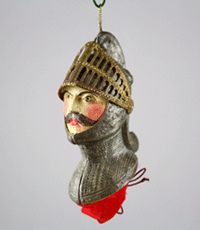
|
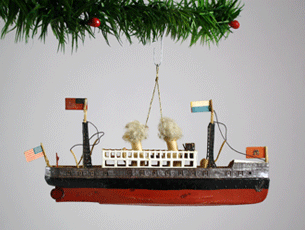
|
|
A knight-in-his-helmet candy container. The visor actually lifts to reveal face. A portion of red silk candy bag is visible.
|
Ocean freighter, $3,000+.
|
The dozen or more Dresden paper factories busily produced decorations and ornaments to satisfy the increasing demand from affluent Americans. These factories used large embossing machines which pressed thin cardboard into metal dies, forming and shaping the intricately designed pieces used for each ornament. Each minutely detailed piece of the ornament required stamping between two dies to form the raised and the depressed side of the individual pieces.
These pieces were taken home by “cottage workers,” often entire families, where they were meticulously assembled and decorated. Most examples were made from silvered or “Dutch gold” card stock, with others painted realistically. Brightly colored lacquers painted over the gold or silver created an iridescent look, particularly on birds and fish. Most often, pieces were two to three inches wide, but unusually large examples, such as ocean freighters, were made 5.5 and 6 inches long. Silk bags were added to hold small pieces of candy, often in the heads of animals, and other bits of trim and embellishment were added before being offered by the dozen for 25 cents up to $2.20 for a most elaborate example. Among the most expensive were a swan head sleigh with rider driven by two plumed prancing horses and an American locomotive with cowcatcher at the front, pull-out candy box, and cotton steam coming from its smokestack.
|
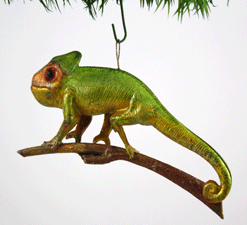
|
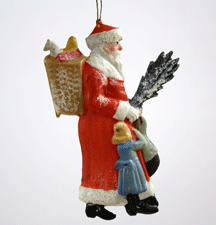
|
|
An iridescent lizard or gecko on a branch, fairly rare, $3,000.
|
Santa Claus with children, a very desirable piece even though it is a Double.
|
Dresdens were made in three different dimensions: flat, double and three-dimensional. A flat required a simple image printed on one side only and painted on the undecorated side; it would obviously be the least expensive. These flat ornaments were often collected and placed in Victorian scrap albums.
Double Dresdens were made with matching images on both sides, such as a heart or shield, without much depth. These pieces with shallow dimension, usually one-eighth inch to one-half inch, would require little workmanship and could easily be assembled, only being glued together. Geometric shapes, such as medallions, leaves or chain links were produced easily and inexpensively.
|
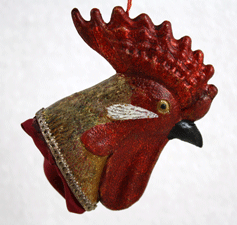
|
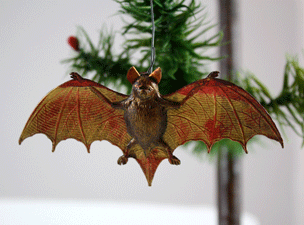
|
|
An Iridescent rooster head candy container
|
An Iridescent bat
|
Three-dimensional Dresdens are highly prized by collectors all over the world. Through the fine detailing in creating molds and artistry in finish work, the pieces were almost perfect miniatures of the objects they represented. These reflected curiosity about exotic animals and people in faraway places, only heard about or depicted in prints and publications.
The most progressive forms of transportation could be represented authentically, down to the most minute detail. The 1903 Winton touring car ornament boasted authentic tufted upholstery, axle, fenders and the hand brake. A most elaborate Russian Troika boasted tasseled harnesses on each horse as the team pulled a lady or man in a magnificent sleigh.
|

|
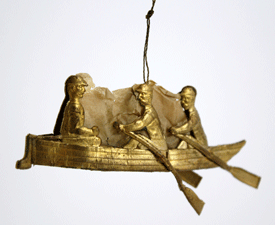
|
|
House with balcony candy container
|
Men sculling with candy bag in hull of the boat.
|
Other ornaments featured: simple farm animals, a prancing circus horse with a performing ballerina holding a garland over her head; a pig with money bags strapped across its back; two men riding a tandem bicycle; and winged cherubs driving a pair of leaping rabbits pulling a seashell sleigh! Many of these examples came in small and large sizes. Basic pieces became much more elaborate with other pieces added. A poodle was made walking, sitting and begging, or even dressed in a tux collar with black top hat, cane and eye glasses. A tree branch could be added as a perch for a painted bunting or an owl, or the owl could have a silk candy bag inserted into his chest. He was sometimes placed on a book beside a feather pen. A horse might be simple and unadorned, but he could have an added saddle, a rider or be attached to a carriage. The most elaborate pieces commanded the highest prices due to the labor involved.
|
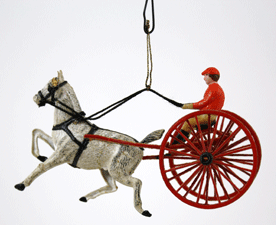
|
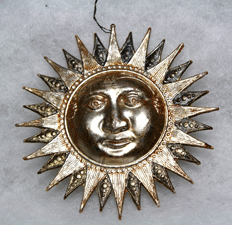
|
|
A man harness racing, using sulky and horse.
|
A Man in the Sun Double, under $2,000.
|
Condition is important in determining values. The most elaborate ornaments and the rarest will bring up to $10,000. I have seen ornaments sell for prices in excess of $8,000 several times at Bertoia Auctions. Many three-dimensional animals and fish can be found in good condition for under $400. Transportation items, such as the freighter or the men sculling, are competitively popular. The angel tree topper and the shield candy box would sell for under $1,000. The peacock and the Man in the Sun would sell for less than $2,000, while the ocean freighter and the gecko usually sell for more than $3,000.
Early feather trees had wide spaces between the rows of branches to display these prized ornaments. Often, these trees were topped by the conical skirt of a gilded girl with chromolithographed face and torso and having beautiful Dresden wings. Branches below could host all kinds of flying creatures and machines. Bats, butterflies, birds and angels look down in the company of hot air balloons, zeppelins and early airplanes. Many of the transportation pieces often bore one or more riders, increasing the value of the piece. Men were often dressed in suits and hats, having sporty mustaches, accompanied by a lady or a young lad. Ladies often had lovely plumed hats and chenille scarves and were snuggled beneath quilted blankets.
|
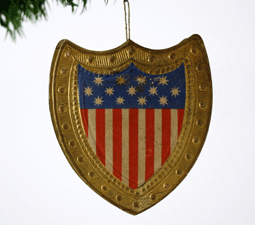
|
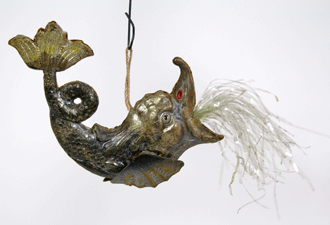
|
|
American flag on Liberty Shield-form candy box, less than $1,000.
|
Winged fantasy fish spewing gelatin streamers.
|
Many Dresdens were produced in response to America's Centennial celebration in 1876. American eagles, Liberty Bells, shields and cannons were produced. Also, sports were represented with golf balls and golf clubs, with or without carrying bags, footballs, basketballs, tennis racquets and polo players on horses. Equestrian themes abound, including ladies riding sidesaddle, and many horses are jumping over obstacles, such as fences and mossy stone walls.
An entire orchestra of musical instruments were enjoyed, as well as chalets, churches and quaint houses. Ornaments in the shape of a gladiator's helmet and a sailor's hat were popular, as were various boots, slippers and ice skates. Colorful gel-fringed poppers often were inserted into mystical animals and animal head ornaments. Poppers are tubular and covered with gilded paper, containing a surprise, such as a party hat inside.
|
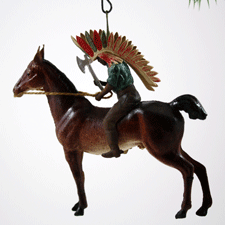
|
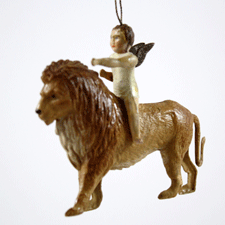
|
|
Indian in a war bonnet on a horse.
|
An angel riding a lion.
|
Many candy container Dresdens, originally purchased as party favors, reflected specific holidays and special occasions. Halloween-related pieces included black cats, bats and jack-o-lantern candy containers. Wedding slippers were quite common. Figures of turkeys can be found, some of which are on a platter ready to be carved.
Today, these fragile, lifelike rarities are sought after by collectors hoping to find their first piece or that rare piece, perhaps a one-of-a-kind example. Most pieces are found through private collections which have become available, as well as through auction houses and antique shows.
|
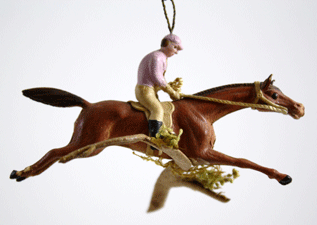
|
A horse, with rider, jumping over an obstacle in steeplechase event.
|
The annual meeting of The Golden Glow of Christmas Past, an international organization for Christmas collectors, is an excellent venue for meeting other collectors, enjoying educational opportunities, and acquiring items for their Christmas decorating.
----------------------------------------
Betty H. Bell has been an antique dealer for 40 years, and she has enjoyed selling holiday items for about 20 years. Her first Dresden purchase, a black and white cow, was made in 1995 and bought for $325. Selling at antique shows and through her website has kept her very busy. Betty can be found at: the Heartland Antique Show held in Novembers; Heart of Tennessee Antique show, February 15-17, 2017; Original Round Top Antiques Fair at the Red Barn, March 27- April 1, 2017; Annual Midwest Vintage Holiday Show, May 28, 2017; and The Golden Glow of Christmas Past Annual Convention, Asheville, NC, August 2-5, 2017.
Betty can be contacted at: 214-478-0332, bettyhbell@aol.com
and www.BettyBell.com.
|